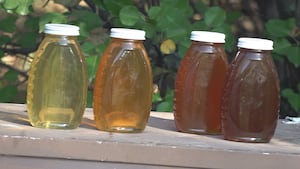Some beekeepers are noticing an unusual side effect from the invasive spotted lanternfly in Ohio.
[DOWNLOAD: Free WHIO-TV News app for alerts as news breaks]
Nina Bagley told our news partner, WBNS in Columbus, that the invasive insects have been a “game-changer” for her bees’ honey production in 2025.
As previously reported by News Center 7, the invasive spotted lanternfly can destroy trees and plants, leading to tens of millions of dollars in damage.
TRENDING STORIES:
Begley told WBNS that beekeeping work is usually done by late summer.
“I usually get June and July light honey, and I pull in June and July, and I stop at the end of July, and August and September we go through a dearth,” she said.
Begley said that she saw an unexpected late-season surge in honey production, all with different flavors, WBNS said.
“I had this really strange, smoky, very thick, very citrusy, kind of had cherry flavors, figs, and different flavors,” she said.
Begley spoke with other beekeepers. She discovered that the changes were likely linked to the spotted lanternfly population in Central Ohio.
“The spotted lanternfly takes out the sap from the tree, excretes it into this thick sugary substance called honeydew,” she told WBNS.
Begley said the one’s appearance has also changed.
“It went from the light locust in the spring, to my summer amber. But I’ve got this, which is a red and smoky flavor,” she said. “And then two days ago I pulled it off again, and it’s a darker flavor,” she said.
Begley continues to reap the benefits from this unusual situation.
Experts have urged residents to kill pests on sight.
[SIGN UP: WHIO-TV Daily Headlines Newsletter]









